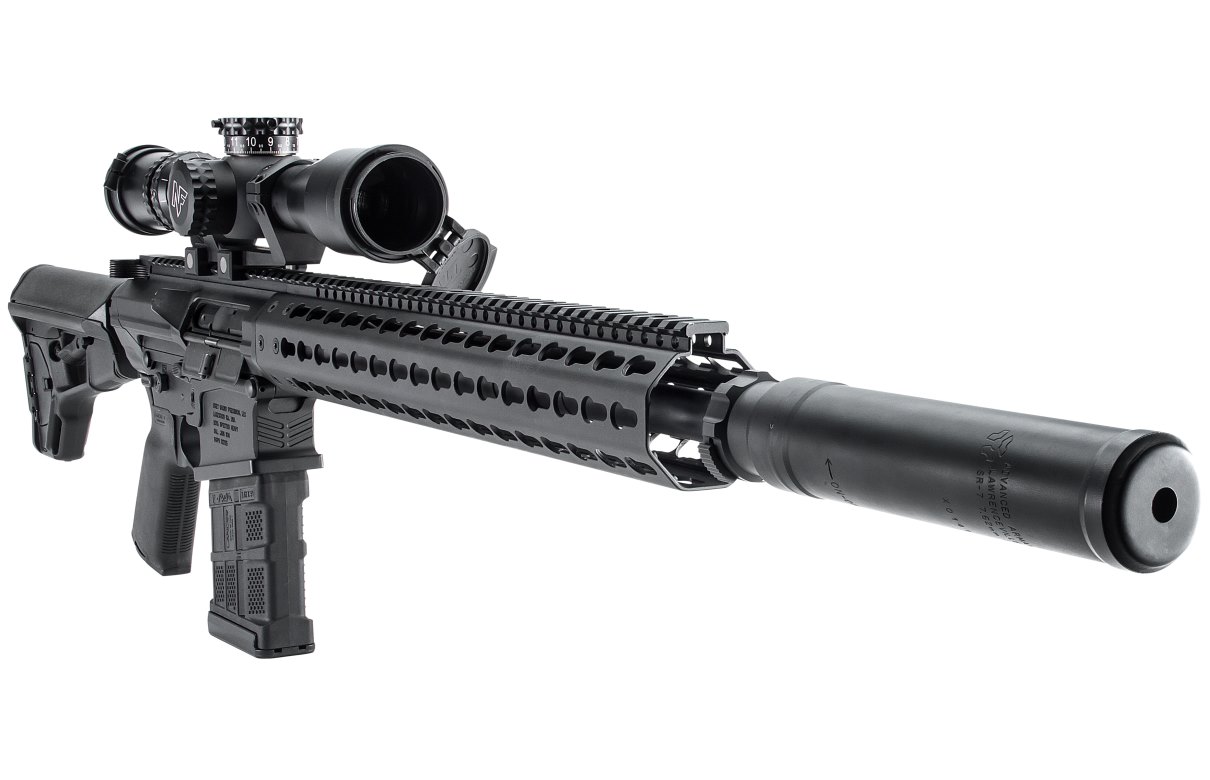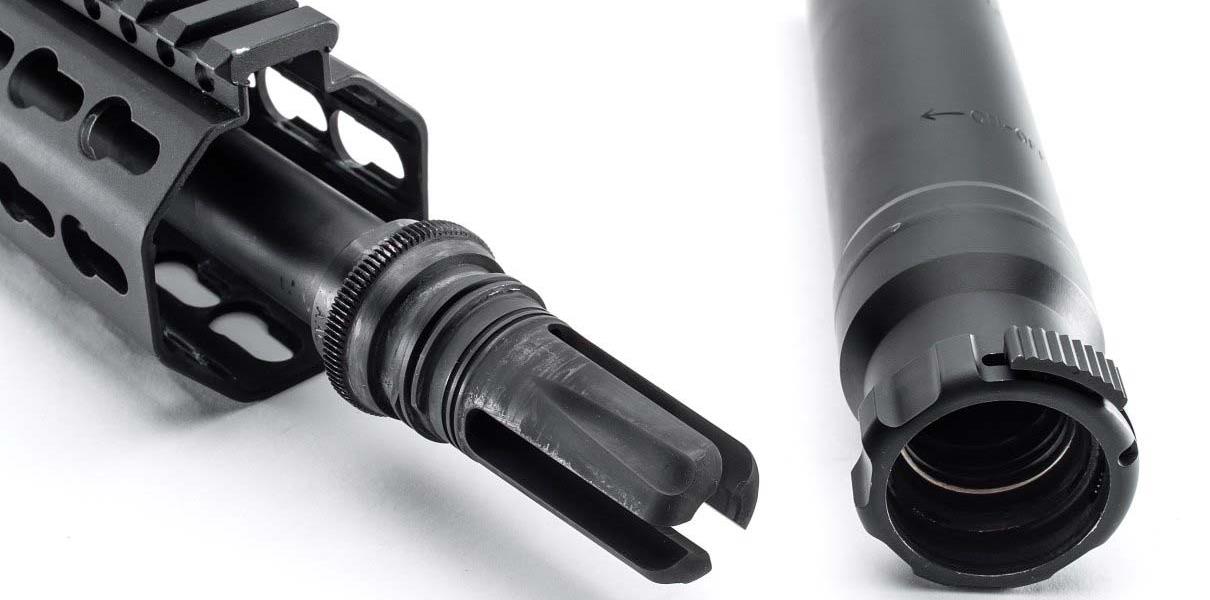Bringing Back the Magic
By: "Shooting Times" Staff Report
 Shooters will find attachment of the SR-7 to be straightforward and simple. (Photo courtesy of "Shooting Times")
Shooters will find attachment of the SR-7 to be straightforward and simple. (Photo courtesy of "Shooting Times")
Advanced Armament's SR-7
In a suppressor marketplace full of new companies and lesser-known names, it’s refreshing to see a manufacturer with a familiar title, one that has been around for a while. Advanced Armament Corp. (AAC) has been making suppressors since 1998. You may remember that AAC was responsible for creating a suppression cult of sorts, with a mass following hungry for whatever the company could churn out next. It was at the top of the suppressor food chain, and you couldn’t whisper the word suppressor without someone chiming in and mentioning Advanced Armament Corp.
AAC’s products were coveted as real-deal, hardcore suppressors that could take a beating while exhibiting excellent sound reduction characteristics. From rimfire suppressors such as the Element and Element 2, to the Ti-Rant .45 AAC, to the nearly bombproof M4-2000 5.56 suppressor, AAC has a wide array of successful suppressors.
Some years ago, AAC was acquired by Freedom Group. This placed them under an umbrella with companies such as DPMS, Bushmaster and Barnes Bullets. If we’re being honest, things slowed with AAC’s suppressor development. That can be a part of growing pains. AAC is still hard at it and bringing new, advanced products to the table.
The .30 caliber suppressor market is quickly becoming crowded. Manufacturers are banking on the large percentage of suppressor buyers to purchase a can that will fill multiple roles and calibers.
In response to industry trends, AAC released the SR-7, .30 caliber suppressor. We received one for review and testing. Upon receipt, we initially noticed its heft. It feels like a tank. We don’t mean that in a negative way, as many of the multi-caliber suppressors are the same. They need to be so that they can take everything the owner will dish out, potentially across several weapons platforms.

Strength and good looks is never a bad thing, and the SR-7 delivers in spades. It has an uncomplicated, all-business design that is appealing to the eye. (Photo courtesy of “Shooting Times”)
The SR-7 weighs in at 19.6 ounces, precisely what AAC claims. The SR-7 has 100 percent Inconel 718 baffles. AAC also claims that backpressure is minimized due to the baffle stack design, including the blast baffle itself. The blast baffle has been redesigned in an effort to retard the erosion that is inevitable when used on short-barreled firearms. According to AAC, the SR-7 fills a void that has been in the silencer industry for some time now. The SR-7 is a battle-rifle silencer built to take abuse and neglect while still performing as designed, but is also capable of making precise and accurate hits when necessary.
AAC SR-7 Specs
Caliber: .30/multi
Weight: 19.6 oz.
Overall Length: 7.6 in.
Materials: Inconel 718,316L stainless steel
Noise reduction: 25 to 39 dB
Attachment Type: 90T ratchet taper mount/Blackout flash hider
Finish: Cerakote
MRSP: $1,096
Manufacturer: Advanced Armament Corp.
We were fortunate enough to speak with Ethan Black of AAC. He gave us valuable insight into the SR-7 and AAC’s approach to design and filling shooter’s needs.
“Previously, we had battle rifle silencers that are designed to perform and hold up under the harshest of environments. They are designed to be used on 10-inch machineguns and hold up just fine. On the other end, we had precision rifle silencers. These are designed to be very light and accurate, but are not designed to take the abuse that our Inconel battle rifle silencers are due to material selection. Each silencer is geared toward its intended applications and are very good at what they do. You wouldn’t choose a chainsaw to cut your hair, and you wouldn’t use scissors to cut down a tree. The same applies with silencers.”

AAC has always been known for tough suppressors, and the SR-7 continues this tradition. The SR-7 is robust and able to withstand a lifetime of use. (Photo courtesy of “Shooting Times”)
“With the SR-series, we have done a few things differently that allow us to bridge that gap. We increased the tooth count on the mounts. We had our 18T mount, then 51, now we have a 90T tapered mount. The increased tooth count helps us lock the silencer onto the mount tighter. A tighter lock up means increased accuracy and precision. Secondly, we added a finer acme thread pitch. This also helps hold the silencer more securely onto the mount and aids tightening the lockup of the silencer. Lastly, we added a low-angle taper to the mount. This is the most noticeable difference to the mount design, and is probably the biggest proponent in bridging the gap between the two silencer types. When the silencer is installed onto the gun, the low-angle taper on the mount wedges itself onto a mating surface inside the silencer. Any one of these improvements would be helpful in making the most efficient dual use silencer to date. When these three improvements are combined, we have a silencer that is more versatile than anything we have ever offered. Through advanced material selection and engineering advances, we have been able to make a stronger, quieter and more versatile silencer.”
If doubts about AAC’s commitment have entered your mind, these words by Mr. Black should erase them.
A thorough visual study of the SR-7 reveals a no nonsense-looking suppressor. It’s simple in design and looks like it was made for hard use. Its matte black Cerakote finish further adds to this perception. It mated up precisely and securely to the provided Blackout 7.62 flash hider via the 90T Ratchet Taper system. Detaching the SR-7 is simple, but this is where a complaint might arise. The Blackout flash hider is a tuning fork of sorts, and hitting it just right emits a high-pitched ring that seems to go on indefinitely. This will probably be of no concern to the casual shooter, but if your weapon is used for more covert operations such as hunting, law enforcement or military, you’ll want to be aware of this should you have the SR-7 detached from the host weapon.

Secure, proper alignment is ensured with the time-tested tooth and ratchet system with AAC’s Blackout flashhider with a 90T tapered mount. (Photo courtesy of “Shooting Times”)
We paired the SR-7 with a Grey Ghost Precision Specter Heavy 7.62. This gun has performed well in the past, and we were curious as to how it would respond to suppression. We shot unsuppressed and suppressed groups using HPR 168-grain BTHP. The GGP did not seem to be particularly fond of this projectile, but we would still be able to measure any accuracy changes. Unsuppressed groups averaged 1.76 inches on a gun that has shot well into the sub-MOA realm in the past with different ammunition. Suppressed groups improved and averaged 1.48 inches. This only tells part of the story. We noticed an interesting improvement in four-shot printing with a flier opening each of the groups. We got one oddball suppressed 2.9-inch group which resembled an unsuppressed 2.7-inch group we’d shot earlier.
Point of impact (POI) shifted an inch low and right of the unsuppressed POI. With the SR-7 removed, the POI returned to its original unsuppressed location, but when the suppressor was reattached, the POI shifted left of the original suppressed location by .5 inches. Extreme spread and standard deviation were also higher with the suppressor attached, and both were already high. Could this be contributing to the sporadic decreases in accuracy?
The GGP rifle and SR-7 required the assistance of a Gemtech Suppressed BCG. Without this BCG switched to suppressed mode, the GGP threatened to beat itself to a pulp from being extremely over-gassed. We were glad to have the suppressor BCG on hand.
AAC SR-7 Performance
| Grey Ghost Precision Specter Heavy 7.62 168 gr. BTHP |
Velocity (fps) |
Standard
Deviation |
Extreme Spread |
Av.
Group (in.) |
Best
Group (in.) |
| Unsuppressed |
2,480 |
17 |
39 |
1.76 |
1.3 |
| Suppressed |
2,495 |
102 |
218 |
1.48 |
.7 |
POI Shift: Yes, .75 in. left.
POI Shift Repeatable: Yes
Conclusion
Consumers need to research and test as many suppressor products as they can before buying. Both the suppressor and host weapon are quality products, but may not be best-suited for each other. Further evaluation of both will be necessary to get a better grasp on the factors that will allow for their optimal suppressed-performance combination.